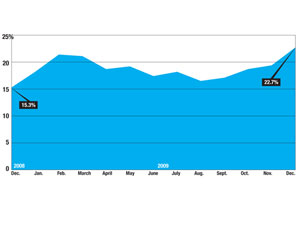Construction’s jobless rate climbed to its highest level in at least a decade, reaching 22.7% in December, the Bureau of Labor Statistics has reported. Economists say the slump in nonresidential building markets has overshadowed the American Recovery and Reinvestment Act’s boost to the public-works sector. The latest BLS monthly figures, released on Jan. 8, show construction’s December unemployment rose from November’s 19.4% and also stood well above the December 2008 level of 15.3%.
The 22.7% rate is the industry’s highest since 2000, when BLS changed its system for classifying and defining industries, a spokesperson says. Construction’s previous post-2000 high was 21.4%, in February 2009. Under the pre-2000 BLS classification system, construction’s peak unemployment rate since 1948 was February 1983’s 27.3%. Construction’s jobless rates aren’t adjusted for seasonal variations.
BLS reported that construction lost 53,000 jobs in December, seasonally adjusted. That includes 23,600 jobs lost among specialty trade contractors, 18,400 in heavy and civil construction and 11,500 in the buildings sector. The December losses bring the industry’s total jobs shed to 1.6 million since the recession began.
The job losses come despite an infusion of billions of federal stimulus dollars since February, when ARRA became law. Robert Murray, McGraw-Hill Construction’s vice president for economic affairs, says ARRA helped public-works construction in 2009, mainly highways, bridges and such government buildings as courthouses. But he adds, “That funding support has only just begun to broaden to include other project types.” (ENR is a unit of McGraw-Hill Construction.)
Murray and other economists also say the drop in nonresidential construction has had a major negative impact. That sector “remains mired in its own recession,” says Anirban Basu, the Associated Builders and Contractors’ chief economist. The Commerce Dept. reported on Jan. 4 that the value of private, nonresidential projects put-in-place in November plunged 20.6% from the year-earlier level.
Another problem is fiscally strapped state and local governments are “cutting projects right and left,” says Ken Simonson, the Associated General Contractors’ chief economist. “The stimulus money...is welcome, but it’s only enough to offset a very small part of that overall decline in both private and state- and local-funded projects,” Simonson says.
Murray says ARRA funding will help some sectors, but not all. “It won’t lift all, and right now the negative of the commercial building downturn is outweighing any benefits from the stimulus act,” Murray says.
Overall, unemployment held at 10.0% in December, the same as November’s level. BLS said 85,000 jobs were lost last month, compared with a gain of 4,000 jobs in November.



Post a comment to this article
Report Abusive Comment